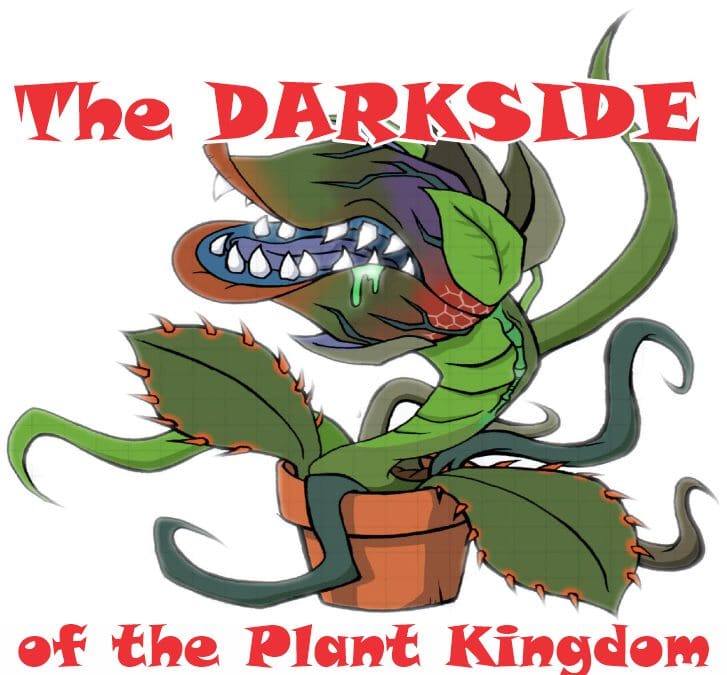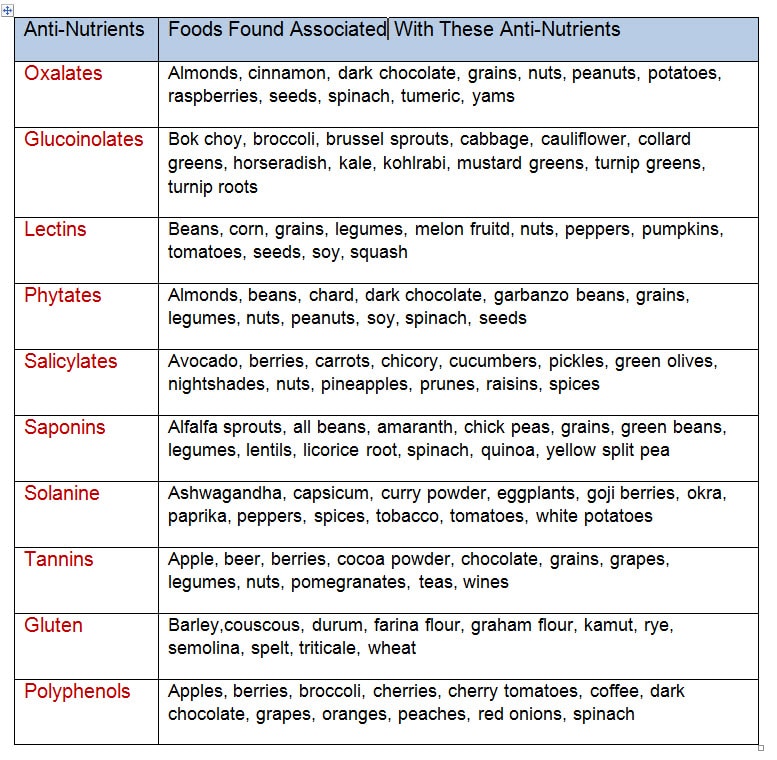
Is There a Downside to Plant-Based Eating? Anti-Nutrients
Introduction:
There is tremendous interest in “plant-based diets” right now. Environmentally, this can be an excellent thing. But there is a sense, I think, that “Plant-Based” also means “healthy,” and this isn’t strictly true. I’ve had many patients and acquaintances talk to me about how they are converting their diets to “plant-based,” assuming that this is the same as a “healthier diet.”
The following article sheds some needed light on the idea that “plants are healthy, animal products are unhealthy.”
Dr. Melodie Billiot
Anti-Nutrients-Is There a Downside to Plant-Based Eating?
Ronald Grisanti D.C., D.A.B.C.O., DACBN, MS, CFMP
In my quest to identify the most effective way of eating, I came across something that has caused a paradigm shift in my thinking on many “healthy” plant foods.
I first need to preface my article on the fact that I have been a “huge” advocate of eating a plant-based diet with minimal meat consumption for as long as I can remember.
My diet typically consisted of drinking a morning smoothie with every type of plant food (spinach, beets, almonds, chard, seeds, etc.) with plant-based protein powder. My lunch was a big salad with more spinach, assorted greens, nuts, and some protein. Dinner was a plate rich in plant foods and some protein. I commonly would eat broccoli, cauliflower, cabbage, Brussels sprouts, beets, etc.
My long-standing question was why in the world was I feeling so bad? Irritable bowel syndrome, joint pain, diarrhea, brain fog, anxiety, difficulty losing weight (fat).
Of course, this does not fit what we have been informed about this way of eating for most people. Of course it was healthy!
So I just pushed forward and continued to eat this way, believing that it was the price I had to pay to be healthy.
But I wasn’t!
My dear wife, Debbie, frequently went to bed with an ice pack on her right hip and right knee. Chronic constipation was the norm. Stuck at an unacceptable weight level was frustrating.
Again we faithfully continued to eat this way, accepting and “preaching” the ultimate benefits of eating an abundance of plant-based foods.
I really never challenged my “strong” belief in eating mainly plants and some protein. One look at my extended library of books would convince anyone that I was on board with plant-based diets, hook, line, and sinker!
By pure coincidence, I came across a book on some of the downsides to eating a heavily plant-based diet.
At first, I was appalled at the thought that plant-based foods may not be the best for “ULTIMATE” health and well-being.
Like I love to do, I dug into the literature and read everything I could on some of the negative effects of eating many plant-based foods.
Wow, what I learned was an eye-opener!
Since tweaking my diet and reducing some of the more toxic plant foods (will discuss shortly), all of the above symptoms vanished. I effortlessly lost weight. My wife, Debbie, was totally free of right hip and knee pain. No more ice bags! And to top it off, she hit a goal weight she tried to accomplish for at least five years!
My thinking and beliefs in a heavily plant-based diet changed.
Today, my goal is to share what I learned, and I hope you give me the time of day to at least listen with an open mind to what I am about to share with you. It could be the tipping point to reversing many chronic, long-standing health issues for many of you reading my article.
Ready?
Plants have something called ANTI-NUTRIENTS.
Anti-nutrients are natural compounds found in plants. Anti-nutrients protect plants from bacterial infections and protect plants from being eaten by predators. Since plants, unlike animals, can’t fight off predators, anti-nutrients are a plant’s self-defense mechanism.
Anti-nutrients are found in all parts of plant-based foods, including vegetables, seeds, and fruits.
Too many anti-nutrients have been found through my research to cause inflammation, gut dysbiosis, arthritis, joint pain, skin issues, and brain fog, to name a few ailments.
A big concern of anti-nutrients is how they interfere with nutrient and mineral absorption.
Here are the top 10 anti-nutrients:
1: Oxalates– Oxalates are found in green leafy vegetables (spinach), sesame seeds, teas, and soybeans. Oxalates can bind to calcium and iron and prevent them from being absorbed. Oxalates are enzyme inhibitors that can prevent proper digestion, cause gut problems and protein deficiencies. Enzymes create chemical reactions in the body that help support our bodies to function properly. Enzymes are especially important in the digestive process. Without the enzymes to properly metabolize food, GI issues can occur, such as bloating and constipation.
2: Polyphenols –Polyphenols known as phytochemicals are anti-nutrients that are touted for their health benefits. Dark chocolate, flaxseed meal, cocoa powder, and many fruits and vegetables contain polyphenol compounds. Polyphenols may have some health benefits, such as possible body weight regulation and decreasing blood pressure, but there are studies on high doses of polyphenols causing kidney damage, tumor development, and altered thyroid hormone production.
3: Gluten– Gluten is a protein that is almost impossible for stomach acid to break down and digest. Dr. Fasano of Harvard, a leading expert on gluten, says that eating gluten can do small amounts of damage to the intestinal lining, creating leaky gut and inflammation in the most susceptible people.
4: Phytic Acid (Phytate)–Phytic acid is primarily found in whole grains, legumes, seeds and some nuts. Phytic acid can decrease the absorption of iron, zinc, magnesium, copper, phosphorous, and calcium. Studies show that phytates can block 80% of zinc-rich foods (cashews, chickpeas), 80% of phosphorous-rich foods (pumpkin seeds, sunflower seeds) and 40% of magnesium-rich foods (spinach, almonds, avocado).
5: Lectins–Lectins are found in legumes (beans, peanuts, soybeans) and whole grains (wheat). They can interfere with nutrient digestion and absorption of calcium, iron, phosphorous, and zinc. Lectins are notorious for surviving GI tract digestion. They can then penetrate the cell lining in the digestive tract and cause damage to gut epithelial cells and membrane lining, change bacterial flora, and trigger autoimmune reactions.
6: Tannins–Tannins are similar to oxalates as they are also enzyme inhibitors. Tannins are found in teas, coffees, wines, and legumes. They can interfere with iron absorption. Tannins have also been shown to impede the digestion of nutrients.
7: Glucosinolates–Glucosinolates are found in cruciferous vegetables (broccoli, kale, brussels sprouts) and can interfere with the absorption of iodine, which can then interfere with thyroid function. Another study of over 100,000 participants found that those who ate the most glucosinolates had a 19 percent greater risk of developing Type 2 diabetes.
8: Saponins–Saponins are found in legumes (green lentils) and whole grains. They can interfere with normal nutrient absorption (iron, zinc) and, similar to lectins, can affect the GI lining, causing leaky gut and autoimmune responses.
9: Solanines–Solanine is found in nightshades (potatoes, eggplants, tomatoes, peppers). For some, these can cause inflammatory bowel disease and autoimmune conditions. Others may feel a slight feeling of poisoning. (nausea, throat burning, headaches, etc.)
10: Salicylates–Salicylates are compounds found in foods, medications and other products that can cause adverse reactions in those who are intolerant. There is much (renewed) interest in the effects of salicylates on food intolerance, attention-deficit disorders, and cardiovascular disease.
The following is a good chart to reference with foods associated with specific anti-nutrients.

Chart Obtained from page 127 of Carnivore Cure–Judy Cho
My conclusions and my continued journey:
Although I have taken a deep dive into some of the pitfalls of eating an abundance of plant-based foods, I sincerely believe there is a middle ground for most people, including myself. I can not deny that many of these plant foods indeed have many health benefits and should not be entirely denied for consumption. On the other hand, I was ignorant of this well-researched downside.
At this point in my 64 years of living on this earth, I am still researching optimal health through many facets, including science-based nutrition.
Today I have presented another side that should not be ignored but at least considered if you, like myself, have strived to achieve optimal health through a plant-based diet.
Just maybe some of these anti-nutrients may indeed be playing havoc on your ability to be free of chronic disease entities.
As I dug deeper in my literature review, I have discovered the least toxic vegetables and fruits.
Here they are:
Vegetables: Avocados, Zucchini, Olives, Cucumber, Pumpkin and Squash
Fruits: Apples, Oranges, Berries, Pineapple, Pears, Melons, Bananas, and Mango
As I continue to use myself as a testing platform and work with many patients, I will report back to you on my findings.
So far, I have been impressed with the results!
Compliments from Functional Medicine University
References:
https://pubs.acs.org/doi/pdf/10.1021/bk-1997-0662.ch001
https://scialert.net/abstract/?doi=pjn.2010.827.832
https://www.functionalmedicineuniversity.com/Anti-Nutrientspaper.pdf
https://www.ncbi.nlm.nih.gov/pmc/articles/PMC7600777/
https://www.hsph.harvard.edu/nutritionsource/anti-nutrients/
https://academic.oup.com/ajcn/article/81/1/326S/4607649
https://academic.oup.com/ajcn/article/65/5/1453/4655482?searchresult=1
https://www.ncbi.nlm.nih.gov/pmc/articles/PMC6996528/
https://pubmed.ncbi.nlm.nih.gov/15302522/
https://pubmed.ncbi.nlm.nih.gov/2598894/
https://poisonousplants.ansci.cornell.edu/toxicagents/tannin.html
https://www.ncbi.nlm.nih.gov/pmc/articles/PMC6669329/
https://www.ncbi.nlm.nih.gov/pmc/articles/PMC6266829/
https://pubmed.ncbi.nlm.nih.gov/8961750/
Carnivore Cure by Judy Cho, NTP
Carnivore Code by Paul Saladino MD
